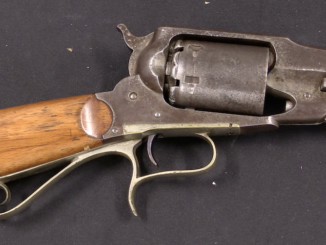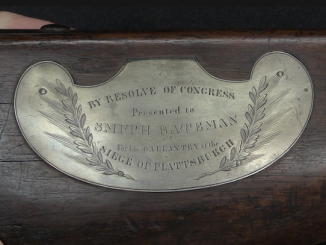The M1915 bolo bayonet was originally the brainchild of US Army Captain Hugh D. Wise, Quartermaster with the 9th Infantry in the Philippines. In 1902, he recommended the implement in a letter to his superior officers, noting that a bolo style of bayonet (ie, one with a widened machete-like blade) would have several advantages over the standard knife bayonet then being issued with the Krag-Jorgenson rifles the US Army was using. Specifically, the wider bayonet would be easier to recover after a thrust (he noted several instances of troopers being killed while trying to extricate their bayonets from enemies) and also (and more significantly) make an excellent and necessary bushwhacking tool in the jungle environment of the Philippines.
Wise’s idea was taken with interest and Springfield produced a series of experimental bolo bayonets, but the project ended there as the 1903 Springfield was adopted with a rod bayonet instead of a blade. Of course, the rod bayonet would be shortlived, and the blade bayonet would come back. The bolo bayonet ideas resurfaced in 1911 when a commission was formed to look into special equipment for the Philippine Scouts. After another series of experimental designs, the M1915 Bolo bayonet was formally adopted on May 22, 1915 and an order was placed for 6,000 of them to be made at Springfield Armory.
Delivery of these bayonets took place in 1915 and 1916, and they proved to be extremely popular tools with the soldiers in the Philippines. They would remain in service on the islands until World War Two, serving at last as a replacement for the M1913 cavalry saber for the 26th Cavalry.




During World War Two, OSS issued their own (non-bayonet) version known as the Smatchet;
https://en.wikipedia.org/wiki/Smatchet
Designed by W.E. Fairbairn, it was closely based on the Welsh Fusiliers trench knife of WW1.
While it was certainly effective enough as a survival-utility tool (variants of the Smatchet are still made for this purpose today, notably by Cold Steel), it was mainly intended as a close-combat weapon. The OSS manual shows that it could easily decapitate a man if swung at his neck with force. In many respects, it was used much like a large Bowie knife.
cheers
eon
Yikes! I would hate to be on the receiving end of that…
I’ve just looked up the ‘ Welsh Fusiliers trench knife of WW1.’ and there is another, even more, fascinating tale. I wonder if there are any know in the USA?
https://collections.royalarmouries.org/first-world-war/type/rac-narrative-134.html
I’d cut brush with this using a soft grip, in part to avoid working up a blister or worse with that odd-looking structure on the belly of the handle. But I expect a Filipino Scout would already know how to do that. As a sword, this old snickersnee is a damn good design, essentially half of a leaf-bladed sword of Bronze Age Greece and elsewhere: straight for thrusting, curved edge for an efficient slash. Now I’m going to do a google to see if anybody makes a modern replica.
It’s also sturdy enough that you can baton it to cut firewood. Not many knives today, even large ones, will stand up to that.
cheers
eon
Did you ax the tree to leave? I got blisters from swinging a splitting maul at a felled pine tree trunk for two hours almost nonstop…
How were you hitting it? A splitting maul is designed to split wood along the grain by being applied to the end grain with as much force as you can muster.
You use a heavy-bladed knife, like a bolo or smatchet, in more or less the same way, except you don’t ‘swing’ it. You whack the middle of its edge into the end grain, then while holding it straight with one hand you hit the square back of the blade with a chunk of wood with enough mass to force it into the grain.
That’s why it’s called the “baton” method, because you’re basically hitting the back of the blade with a wooden club.
If you’re trying to cut up a trunk, you should be using a felling axe. Or better yet a crosscut saw, a pair of sawhorses, and somebody at least as husky as you are on the other end of the saw.
There are five basic types of axes you need for serious lumbering;
https://gizmodo.com/the-5-types-of-ax-everyone-should-know-508726882
Axes are like golf clubs. You actually need several of them to “play through”.
cheers
eon
Thank you eon.
I may not ever have to fire a gun again, but I am certain I will chop with an axe, and your link has taught me several reasons why I have almost always chopped like a man with marshmallow. I was using a ‘splitting maul’ to try chop cross grain with (although, to be fair, nobody was paying me so nobody cared how bad I was at it).
I hope Ian manages to do a FW on a WWII Smatchet; and an original Welsh Fusiliers trench knife would be so very good indeed: although The Imperial War Museum has the only surviving one that I’ve found on the internet.
You should be using an axe or saw for the that duty. The proper tool for the job!
I’ve used my Buck folding knife to split firewood many times, by whacking the blade with another piece of wood. Not as easy as with that bolo knife, but it works!
Oh and the current U.S. bayonet (M-9 I think) is while not a bolo certainly has a lot of potential for whacking.
There are no real modern replica available. I’ve been waiting and looking for 12 years.
Windlass Cutlery makes nice reproductions of the 1909 and the 1919 bolo knives, The Smatchet, and the Welsh Fusiliers short sword, all complete with equally lovely reproductions of their respective sheaths. They are sold through Atlanta Cutlery’s website. The 1919 Bolo knife is basically identical to the bayonet with the exception that it has a solid crossguard and no bayonet catch. Curiously enough, not only are they high quality, somehow they also manage to be rather inexpensive. 1909=$89, 1919=$99, Smatchet=$67, Welsh Fusiliers Sword=$99(out of stock at Atlanta Cutlery, but in stock at IMA).
Windlass is an Indian company and all their manufacturing takes place in India, which explains the affordable pricing.
On one website they have an originsl 1909 Bolo Bayonet along with the SpringField Model of 1903 Rifle for $11,000.00
The locking attachment on the 1909 Bolo Bayonet is more a Mauser 1898 style , while the 1915 Bolo Bayonet has the 1905 Springfield bayonet lock up.
Regarding the hook on the pommel, it is likely there to facilitate “draw” cuts. That is where you pull back at the same time you chop, to make a kind of hybrid chop/slice. It makes the chop much more effective. A lot of south East Asian blades (such as goloks) have a hooked handles to allow draw cuts.
Bolos were also issued to machine gunners both in Europe and in The Siberian Expedition. I don’t know about Archangelsk/Murmansk but I assume so as well.
You can see them worn in some images, notably in this one where US troops are training with a Hotchkiss mle 1914
https://64.media.tumblr.com/dcf24316995e1bef06247d482e7d8a11/tumblr_mvyg1avcE81s57vgxo2_r1_1280.jpg